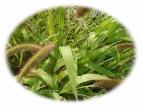 To recap on other Cereal postings on this blog:
To recap on other Cereal postings on this blog:Oats:8th April; Barley:14th April; Maize:23rd April; Buckwheat:2nd May;
Quinoa:15th May;Brown Rice:24th May;Rye:5th June;Wild Rice:11th June
Millet is documented as growing in Switzerland in the Stone Age and it was grown as early as 2700 BC in China. Millet has also been used in Africa and India as a staple food for thousands of years. Millet was introduced to the U.S. in 1875. Today millet ranks as the sixth most important grain in the world.
Millet is tiny in size and round in shape and can be white, gray, yellow or red. The most widely available form of millet found in stores is the pearled, hulled variety and millet couscous which is made from cracked millet. It is tasty, with a mildly sweet, nut-like flavor.
Highly nutritious, non-glutinous and non-acid forming, millet is easy to digest. It is considered to be one of the least allergenic and most digestible grains available and it is a warming grain so will help to heat the body in cold climates. It contains approx 15% protein, high in fiber and B-complex vitamins including niacin, thiamin, and riboflavin, the essential amino acid methionine, lecithin, and some vitamin E. It is particularly high in the minerals iron, magnesium, phosphorous, and potassium. Millet is the only grain that retains its alkaline nature when cooked and it is ideal for those who are allergic to wheat and gluten.
Store millet in an airtight container in a cool, dry and dark place or the refrigerator, where it will keep for several months.
Whole grain millet can be sprouted. Husked millet can be soaked and used in muesli with nuts and fruit, cooked in the place of rice or added to vegetable dishes. To cook as rice, simmer ½ cup in 1½ cups of liquid, leave it alone as it cooks and you'll get fluffy grains like rice. To make raised bread using millet flour, combine with wheat flour or used alone to make flat bread like roti.
Vegan Millet and Berry Uncheesecake
The Recipe Cottage
1 cup oatmeal
1/2 cup whole wheat flour
1/2 cup finely ground almonds
walnuts or sesame seeds
1 ts cinnamon
1/4 ts salt
1 ts vanilla
3 tb liquid sugar (maple syrup or honey)
1/4 cup vegetable oil
1 tb concentrated orange juice
1/2 cup millet, uncooked
2 cups water
1/2 ts salt
1/3 cup unsalted cashews
1/3 cup lemon juice
1 ts grated lemon rind
1/3 cup maple syrup or honey
1 ts vanilla
1 ts lemon extract (optional)
2 to 3 cups berries or sliced fruit (strawberries, kiwis, peaches, plums, etc.)
2 to 3 tb all-fruit jelly or jam, melted (optional)
1 drop almond extract (optional)
In large bowl combine oatmeal, flour, almonds, walnuts, cinnamon and salt. Mix well. In smaller bowl combine vanilla, sugar, oil and orange juice. Carefully add wet to dry ingredients without
over-mixing. Press firmly into sides and bottom of a 9 or 10 inch pie plate. Bake in 350 F oven for 9 to 12 minutes until lightly browned. Cool before filling.
In saucepan, place millet, water and salt. Bring to a boil, cover and simmer for about 45 minutes, until water is absorbed and millet is soft. Meanwhile, in blender or food processor, add all remaining ingredients. Puree for about 1 minute, until perfectly smooth. Scrape down sides, if necessary. When cooked millet is still warm, add it to blender mixture. Process for about 1 minute, until creamy and smooth. You may have to stop blender and push mixture down with a rubber spatula and stir to blend. Pour into cooked pie shell. Chill.
Arrange fruit over filling and serve, or prepare a glaze as follows: Add almond extract to melted jelly. Brush fruit with melted jelly. Chill. Makes 8 to 10 servings.
Tip: Press crust into plate with your hands inside a plastic bag. No mess!
Tabs : cereals grains vegan diet health millet
No comments:
Post a Comment